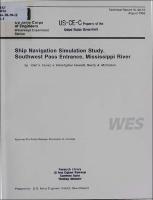Please use this identifier to cite or link to this item:
https://hdl.handle.net/11681/13386| Title: | Ship navigation simulation study, Southwest Pass Entrance, Mississippi River |
| Authors: | United States. Army. Corps of Engineers. New Orleans District Huval, C. J. Hewlett, J. Christopher McCollum, Randy A. |
| Keywords: | Deepwater channels River navigation Ship simulation Mathematical models Ship channels Southwest Pass, Louisiana Mississippi River Ship maneuvering Navigation channel design Ship piloting |
| Publisher: | Hydraulics Laboratory (U.S.) Engineer Research and Development Center (U.S.) |
| Series/Report no.: | Technical report HL ; 96-12. |
| Description: | Technical Report Abstract: Southwest Pass, Mississippi River, is the main deep-draft navigational entrance into the Mississippi River and provides ocean access to the Ports of New Orleans and Baton Rouge, as well as other terminals servicing the many industries along the lower river. The pre-project channel was authorized at 600 ft wide and 40 ft deep, and proposed to be deepened to 45 ft to accommodate greater inbound tanker ships and outbound bulk grain carriers. The purpose of navigation ship simulation study was to determine the required channel width in the Southwest Pass to provide safe and efficient ship navigation, consistent with the minimum width to reduce dredging. To optimize the channel width, the then-existing charmel was simulated and the results compared with several alternate channel widths including 600, 675, and 750 ft. The study included Mississippi River flows including a high flow of 1,300,000 cfs and a low of 640,000 cfs to bracket the normally expected range of velocities. Current velocities were developed using the TABS modeling systems. Only the entrance area of the Southwest Pass region was simulated and studied. Pilots from the Louisiana Bar Pilots Association participated in the simulation validation and formal pilot testing of the channel alternatives. Tankers of 763-ft length and 125-ft beam loaded to 39-ft draft were used in the existing channel, and tankers of 840-ft length, 138-ft beam, and 44-ft draft were used in the proposed deepened entrance channel. Test results for all piloted simulations were analyzed and included ship track plots and statistical analysis of key ship control parameters, such as ship rudder usage, ship speed, rate of turn, channel edge clearance, etc. The simulation test results showed that the larger design ship will be able to safely navigate through the Southwest Pass entrance into the Mississippi River. Based on the study, it was recommended that the entrance channel width be increased from 600 ft to 700 ft for a short distance of about 3,000 ft on the western edge of the entrance channel. |
| Rights: | Approved for public release; distribution is unlimited. |
| URI: | http://hdl.handle.net/11681/13386 |
| Appears in Collections: | Technical Report |
Files in This Item:
| File | Description | Size | Format | |
|---|---|---|---|---|
| TR-HL-96-12.pdf | 4.07 MB | Adobe PDF |  View/Open |